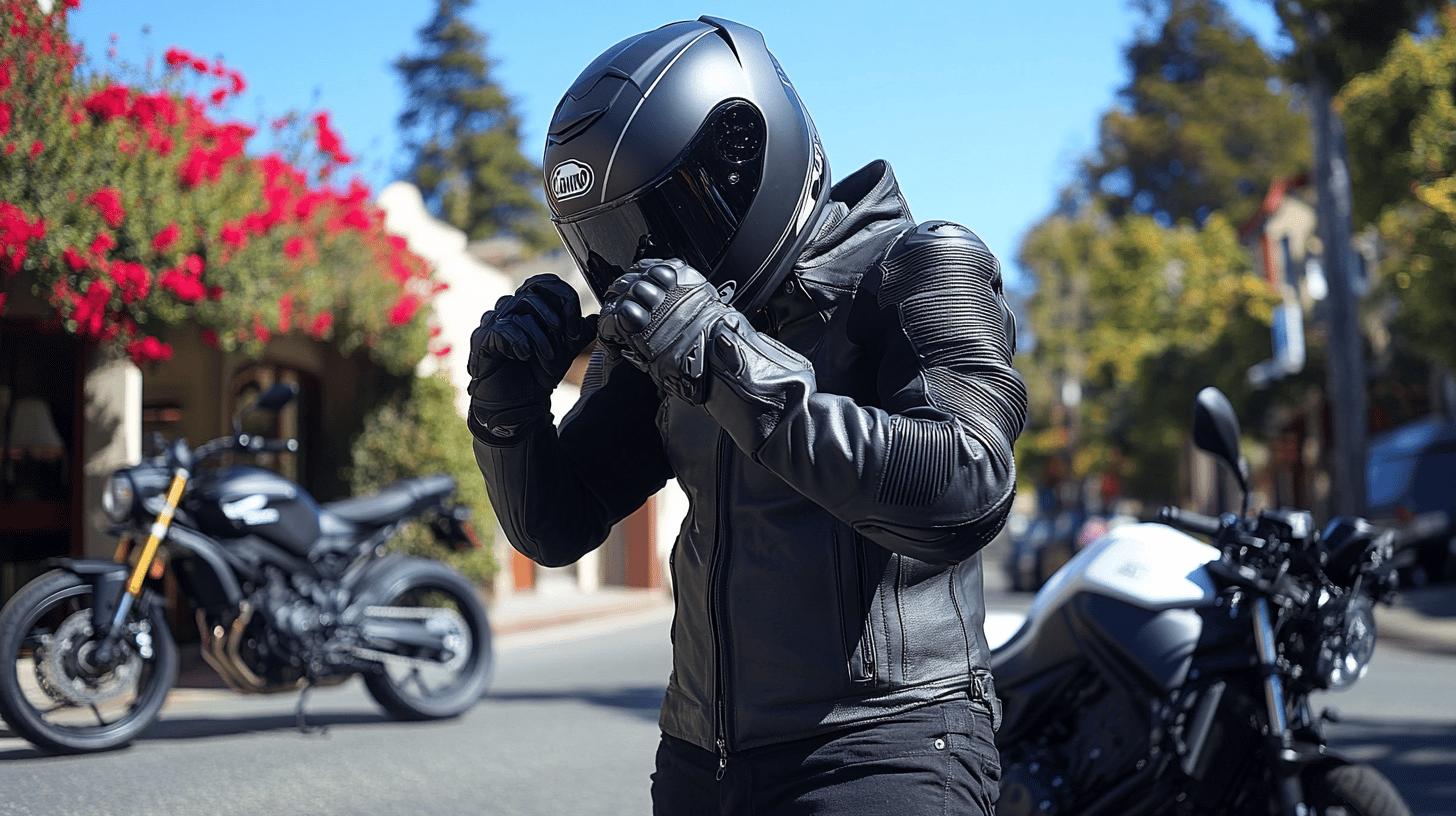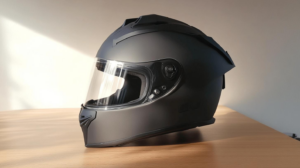Can wearing earbuds in your motorcycle helmet be a double-edged sword? While they offer the allure of entertainment and navigation cues, they also present safety concerns like distraction and obstruction of crucial road sounds.
Striking the right balance between seamless audio experience and road safety is essential. This article delves into how you can enjoy the benefits of earbuds while ensuring safety.
Discover practical tips for fitting, volume management, and usage limits, all geared towards an optimal riding experience without compromising on-road awareness.
How to Wear Earbuds in a Motorcycle Helmet Safely

Wearing earbuds in a motorcycle helmet can present significant safety risks. A primary concern is distraction, as earbuds can divert attention away from the road. Blocking important sounds, such as honking horns or emergency sirens, can also pose dangers.
Riders must be aware of their surroundings to ensure their safety and the safety of others on the road. The use of earbuds should be approached with caution, balancing personal enjoyment with necessary road awareness.
Adjusting the volume of earbuds is crucial to prevent hearing damage. Excessively high volumes can lead to long-term hearing issues, particularly when used to overcome wind and road noise.
Riders should set the volume to a level that allows them to hear ambient sounds, enabling them to remain alert to their environment. Maintaining a safe volume is essential for both hearing health and situational awareness.
Ensuring that earbuds fit properly is vital to avoid them falling out during rides. A secure fit not only enhances sound quality but also minimizes distraction from adjusting or losing earbuds while riding. Selecting earbuds with adjustable tips or wings can offer a more customized and stable fit, accommodating different ear shapes and helmet sizes.
Using earbuds only when necessary is advised to maintain road awareness. Continuous use can lead to an over-reliance on audio cues, potentially diminishing a rider's ability to react to external stimuli. By limiting usage, riders can enjoy audio content while still prioritizing their safety.
-
Proper volume control
-
Secure fitting
-
Use high-quality earbuds
-
Situational awareness
-
Limit usage time
Choosing the Best Earbuds for Motorcycle Riding

Selecting the best earbuds for riding is crucial for both comfort and safety. The first consideration should be finding earbuds that fit well under a helmet, ensuring they are comfortable during long rides. A snug fit prevents the earbuds from moving or falling out, which can be distracting and inconvenient.
High-quality earbuds typically come with various tip sizes and shapes to accommodate different ear canals, providing a secure fit without exerting excessive pressure on the ears. This not only enhances comfort but also maintains sound quality, which is essential for clear audio while riding.
Sound quality and durability are critical features to evaluate when choosing earbuds for motorcycle riding. High-quality sound ensures clear audio even when faced with the ambient noise of the road. Durable earbuds, often made from robust materials, withstand the rigors of riding, such as exposure to wind, dust, and occasional rain.
Waterproof or weather-resistant designs add an extra layer of protection, ensuring the earbuds remain functional in diverse weather conditions. Reliable and consistent sound quality is vital to avoid distractions and maintain focus on the road.
Helmet-friendly designs are advantageous, as they prevent discomfort and ensure the earbuds fit seamlessly within the helmet. Low-profile earbuds reduce the risk of creating pressure points that can lead to discomfort or even pain during extended rides.
These designs often integrate features that keep the earbuds discreetly tucked against the ear, avoiding interference with helmet padding. Opting for helmet-friendly options can significantly enhance the riding experience by minimizing the need for constant adjustments and allowing the rider to concentrate on the journey.
Features to Look for in Riding Earbuds
-
Snug and secure fit
-
High-quality sound
-
Durability and weather resistance
- Low-profile design
Adjusting Your Helmet for Optimal Earbud Use

Adjusting a motorcycle helmet can significantly enhance the comfort and security of earbuds during a ride. Proper helmet fitting is essential to prevent pressure on the ears, which can lead to discomfort or pain. One effective strategy is to modify the helmet's interior padding or cheek pads.
By carefully adjusting these components, riders can create additional space for earbuds, ensuring they fit snugly without being dislodged. This modification helps maintain a secure fit, allowing riders to enjoy audio without constant adjustments. Ensuring the helmet fits correctly will also prevent excessive movement, which can cause earbuds to fall out during rides.
Potential modifications include repositioning cheek pads or replacing them with thinner alternatives to better accommodate earbuds. Such adjustments allow the earbuds to sit comfortably within the helmet, avoiding pressure points that can cause discomfort. When modifying helmet padding, it's crucial to maintain the helmet's protective integrity.
Riders should aim for a balance between comfort and safety, ensuring that any changes do not compromise the helmet's ability to protect in the event of an impact. By focusing on these adjustments, riders can achieve an optimal setup for earbud use, enhancing both comfort and auditory experience.
| Adjustment Strategy | Benefits |
|---|---|
| Modify cheek pads | Increases space for earbuds |
| Use thinner padding | Reduces pressure on ears |
| Reposition helmet padding | Ensures secure earbud placement |
| Maintain helmet integrity | Balances comfort with safety protection |
Pros and Cons of Earbuds Versus Helmet Speakers

Earbuds offer a highly personal audio experience for motorcycle riders, providing a direct and immersive sound environment. Their compact size makes them easy to carry and store, fitting conveniently under most helmet designs.
Noise isolation is another advantage, as earbuds can effectively block out wind and road noise, ensuring clear audio delivery. Despite these benefits, earbuds pose certain safety risks. They can distract riders by reducing their awareness of the surrounding environment, including critical sounds like horns or sirens.
Additionally, earbuds might cause discomfort during long rides, as the pressure against the ear can become irritating. This limited awareness and potential discomfort are important considerations when opting for earbuds.
In contrast, helmet speakers are designed to integrate seamlessly into the helmet, offering a more comfortable audio solution that doesn't place pressure directly on the ears. A significant advantage of helmet speakers is their ability to allow ambient noise awareness, maintaining the rider's connection with the environment.
This feature enhances safety by ensuring that important external sounds are not entirely blocked out. However, helmet speakers often deliver lower sound quality compared to earbuds, partly due to their design and positioning within the helmet.
External noise interference can also be an issue, as the open design may not filter out surrounding sounds as effectively. Additionally, the fixed installation of helmet speakers means less flexibility in terms of use and portability compared to earbuds.
-
Earbuds Pros: Personal audio experience, compact size, noise isolation.
-
Earbuds Cons: Potential safety risks, discomfort, limited awareness.
-
Helmet Speakers Pros: Ambient noise awareness, comfort, integrated design.
- Helmet Speakers Cons: Lower sound quality, potential for external noise interference, fixed installation.
Legal and Ethical Considerations for Using Earbuds While Riding

Are earbuds legal to use while riding a motorcycle? In most states, there are no specific restrictions against using earbuds while riding. However, the responsibility falls on the rider to stay informed about regional laws as they can vary significantly.
Checking local regulations is crucial to ensure compliance and avoid fines or penalties. Laws may change, so keeping up-to-date with any legislative updates regarding earbud use on motorcycles is advised.
What are the ethical considerations of using earbuds while riding? Ethically, riders must weigh the impact of earbuds on their road awareness and safety. While personal audio can enhance the riding experience, it should not compromise the ability to hear essential road sounds such as sirens or horns. Balancing personal audio desires with public safety is vital.
It’s essential to consider how earbuds might detract from overall riding safety and to use them responsibly to maintain a conscious connection with the riding environment.
-
Check local laws and regulations
-
Consider ethical impact on safety
-
Balance personal audio desires with public safety
- Stay informed about updates in legislation
Final Words
Navigating the intricacies of how to wear earbuds in a motorcycle helmet involves balancing enjoyment with safety. Understanding the risks, like distractions and blocked sounds, is as vital as adjusting helmet fit for comfort. Selecting quality earbuds enhances the riding experience without compromising awareness.
Comparing earbuds to helmet speakers allows riders to choose based on personal and situational needs, while legal and ethical considerations remind riders to stay informed and responsible on the road. Embrace the journey knowledgeable and safe.
FAQ
Can you wear earbuds under a motorcycle helmet?
Yes, you can wear earbuds under a motorcycle helmet. Use low-profile earbuds for a secure fit, ensuring they do not cause discomfort or fall out when putting on or removing the helmet.
How can I listen to music in my motorcycle helmet?
You can listen to music in a motorcycle helmet by using Bluetooth helmet speakers or earbuds. Bluetooth options provide connectivity without wires, while earbuds may offer noise isolation for better sound quality.
How to wear earbuds in a motorcycle helmet without them falling out?
To prevent earbuds from falling out, choose earbuds with a snug fit and consider adjusting helmet padding to accommodate them. Proper placement and fit are essential for ensuring they remain secure during rides.
What is the correct way to wear earbuds in a motorcycle helmet?
The correct way to wear earbuds involves placing them securely in your ears, ensuring a snug fit without causing discomfort. Adjust helmet padding to accommodate earbuds and prevent pressure on your ears.
How to wear AirPods with a motorcycle helmet?
Wearing AirPods with a motorcycle helmet involves placing them securely in your ears and adjusting the helmet's padding to avoid excessive pressure. Ensure a proper fit to prevent them from falling out while riding.
What are the best earbuds to use with a motorcycle helmet?
The best earbuds for use with a motorcycle helmet include wired or wireless options with a low-profile design, high-quality sound, and a secure fit to prevent discomfort and ensure they stay in place during the ride.
What are low profile earbuds for helmets?
Low-profile earbuds are designed to fit snugly within the ear without protruding, minimizing discomfort and interference with helmet padding. They remain secure under the helmet, making them ideal for motorcycle riding.
How to fit earphones in a helmet for optimal use?
For optimal use, fit earphones by adjusting helmet padding and cheek pads to create space without applying pressure. A proper fit ensures comfort and prevents earbuds from falling out during rides.
What are the risks of wearing earbuds in a motorcycle helmet?
Wearing earbuds can block important road sounds, leading to potential safety risks. Distraction and reduced awareness of the surrounding environment are significant concerns when using earbuds while riding.

Mark Anderson is a trusted expert with over 25 years of riding experience. At 56, his deep knowledge of long-distance touring and participation in major motorcycle rallies makes him a reliable source for gear recommendations on ProtectiveGearz. Mark’s decades of firsthand experience ensure his advice is authoritative and valuable to riders seeking expert guidance.



